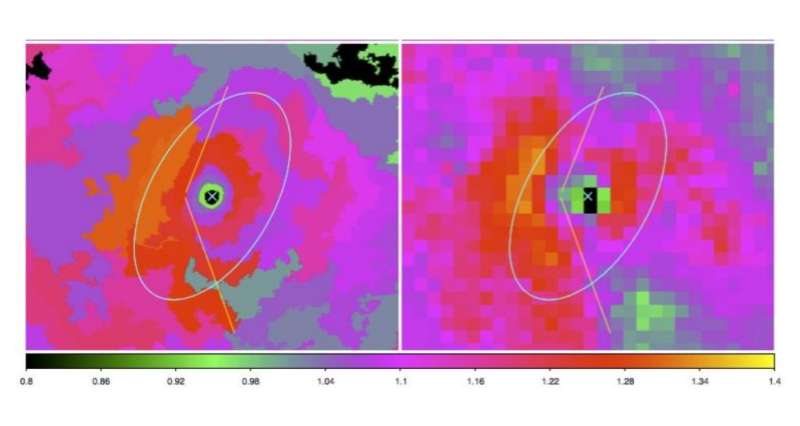June 27, 2017 report
Galaxy NGC 1132 has a disturbed hot halo, study finds

(Phys.org)—A new study recently published on arXiv.org reveals that the fossil group galaxy NGC 1132 (also known as UGC 2359) has a disturbed and asymmetrical hot halo. The findings provide new insights into the formation and evolution of this galaxy and could improve our understanding of fossil groups in the universe.
Located some 318 million light years away from the Earth, NGC 1132 is a well-known fossil galaxy group. The so-called "fossil group" is an isolated elliptical galaxy embedded in an extended halo of X-ray emitting gas the size of a galaxy group. Such groups are believed to be the end result of galaxy merging within a normal galaxy group, leaving behind the X-ray halo of the progenitor group.
When it comes to NGC 1132, it is similar to other fossil groups. Previous observations show that it has an extended X-ray luminous halo, as in other fossil groups. It is also known to be a slow rotator with a core radial profile at the center, which is similar to typical old giant elliptical galaxies. All in all, NGC 1132 is expected to be old and relaxed long after the giant elliptical galaxy assembly.
However, the new research presented by a team of researchers led by Dong-Woo Kim of the Smithsonian Astrophysical Observatory (SAO) in Cambridge, Massachusetts, suggests that NGC 1132's hot gas morphology is disturbed and asymmetrical, with a cold front following a possible bow shock.
"We found that the hot gas is disturbed, in contrast to the conventional view that the hot halo in the fossil system would be relaxed and undisturbed," the researchers wrote in the paper.
Kim's team has analyzed archival data provided by NASA's Chandra X-ray Observatory as part of the Chandra Galaxy Atlas project. The spacecraft observed NGC 1132 in 1999 and 2003 with its Advanced CCD Imaging Spectrometer (ACIS).
The analysis revealed important details about NGC 1132's hot gas morphology. The new results indicate that the system is quite disturbed with an asymmetric hot halo, including a sharp edge to the east and extended emission to the west.
"The Chandra data revealed a cold front at r~10 kpc to the east of the center and an extended hot gas region toward the west. There may be a possible shock at r~20 kpc just ahead of the cold front," the paper reads.
The researchers noted that the disturbance in the hot halo of NGC 1132 is most likely caused by a recent minor merger of a small galaxy with a low impact parameter.
"This hypothesis is consistent with recent simulations of rejuvenated fossil systems and the evidence of recent galaxy interactions provided by optical observations," the astronomers wrote in the paper.
According to the authors of the paper, the new findings show that the paradigm of the fossil system needs to be reconsidered. The researchers also underlined the need of further Chandra observations of the NGC 1132 system in order to put their results on a stronger statistical base.
More information: Disturbed Fossil Group Galaxy NGC 1132, arXiv:1706.04609 [astro-ph.GA] arxiv.org/abs/1706.04609
Abstract
We have analyzed the Chandra archival data of NGC 1132, a well-known fossil group, i.e. a system expected to be old and relaxed long after the giant elliptical galaxy assembly. Instead, the Chandra data reveal that the hot gas morphology is disturbed and asymmetrical, with a cold front following a possible bow shock. We discuss possible origins of the disturbed hot halo, including sloshing by a nearby galaxy, ram pressure by external hotter gas, merger and nuclear outburst. We consider that a minor merger with a low impact parameter is the most likely origin: NGC 1132 may be a rare example of unusual late mergers seen in recent simulations. Regardless of the origin of the disturbed hot halo, the paradigm of the fossil system needs to be reconsidered.
© 2017 Phys.org



















